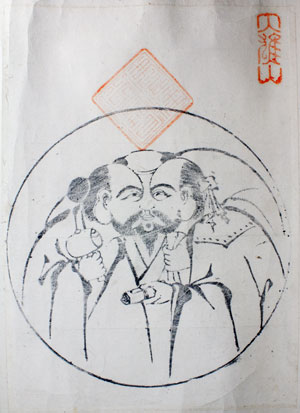Dutiful. Methodical. Curious. Public. W00t.
(I'd like to be able to tell stories about the magic moments of the art life and living with history. This is sort of a first draft of one such episode.)
4.13.2013. It pays to be dutiful. It pays to be methodical. It pays to be curious. It pays to share.
I'm not talking about "pay" as in "payday." I'm talking about a payoff in those sparkly moments when some new connection is made -- intellectual, spiritual or personal. It is a new light where there was darkness. It is the soft murmur of yes from the universe.
I am dutiful. I catalog everything that comes out of Jim's closet of collections. In May 2011, next up was a makimono -- a long horizontal handscroll from Japan. It was undramatic. Mounted on the scroll were dozens of mass-produced black and white woodblock prints -- like someone's scrapbook.
I am methodical. I could just take a snapshot of the handscroll, slightly unfurled to show a sample of its contents, and pronounce it done. But who knew when it might ever be opened again. And since it seemed so old, repeatedly opening it up to remind us of the contents didn't seem smart. So, I changed the camera set-up and photographed every print.
I am curious. The prints were full of Buddhas, dieties, and other curious characters, with captions in Japanese. What were they? I remember the day that Jim and I sat at the kitchen table with the print-outs and some reference books to try to figure out what we were seeing. It became clear that we were in the realm of "esoteric Buddhism" -- the offspring of the rich Tibetan traditions -- and we were able to identify many of the figures. Our largely forgotten learning of Chinese characters helped us figure out that many of the captions referred to temples. Every little fragment of information provided a new Google search term and opened a new line of inquiry.
So it appeared that we had a collection of souvenirs from Japanese temples. They were mementos like holy cards in the Catholic tradition.
I share. The makimono contents were still a bit mysterious. I posted the humble prints on Flickr (along with a few similar ones that Jim had found in a St. Louis shop), without much hope that anything would come of it. (See slide show below or at Flickr.)People who browse Flickr are usually looking for photography. But you never know...
Months go by.
Sparkly moment. A year after we puzzled over the prints at our kitchen table, we were in Ireland. I got an email:
I have just viewed your collection of Buddhist prints and wondered if you knew that there is considerable interest in this subject at the moment in Europe. I also collect this kind of material and am holding an exhibition and symposium next week in London on the topic. There was also a two day conference held at the College de France in Paris in March. If you’d like to be part of the group interested in furthering knowledge and display of this kind of material, let me know. I am associated with the School of Oriental and African Studies (SOAS) at the University of London.
As I looked out my hotel window to the rain-soaked Dublin streets, the world was suddenly a little brighter, a little richer. The unmet friend had followed the breadcrumbs and found me.
In our correspondence that followed, SG put the prints in context. During the Tokugawa Shogunate (1600-1868), Buddhist and Shinto practices intermingled comfortably. At Shinto shrines and Buddhist temples, pilgrims collected these ofuda, mementos that convey blessings and serve as amulets in the pilgrims' homes. In 1868, with the dawn of the Meiji Restoration and renewed Japanese nationalism, Buddhism was outlawed as foreign idolotry in favor of the native Shinto practice. The ephemeral Buddhist-themed prints became a thing of the past.
In an act of pure kindness, SG managed to translate nearly all the legible labels, including (where noted) the identification of the temples that issued them.
What is my conclusion? Everyone of us possesses some gold -- whether it's an odd item found in the back of the drawer or a piece of family history or a talent for art. But it's that kind of magic, fairy-tale gold that is only worth something if you give it away. And the more you give it away, the more you have.


